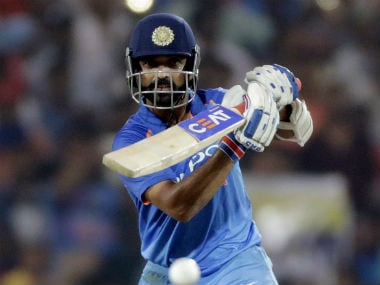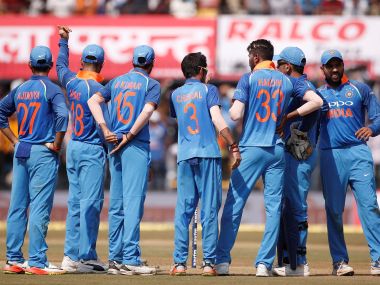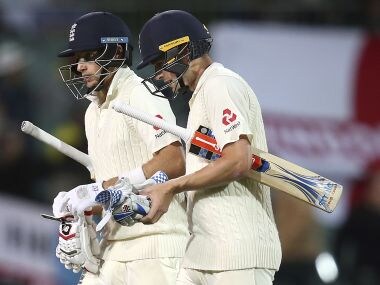Ashes 2017: England bowlers prepared well for Australian conditions, but failed to adapt to situations in Adelaide Test
After defeats at Brisbane and Adelaide, Perth will present England one final chance to keep the series alive.
Gaurav Joshi, Dec, 09 2017
- ICC World Cricket League Championship, 2015/17 HK Vs PNG Hong Kong beat Papua New Guinea by 93 runs
- Afghanistan and Ireland in UAE, 3 ODI Series, 2017 AFG Vs IRE Ireland beat Afghanistan by 51 runs
- ICC World Cricket League Championship, 2015/17 HK Vs PNG Hong Kong beat Papua New Guinea by 23 runs
- Afghanistan and Ireland in UAE, 3 ODI Series, 2017 AFG Vs IRE Afghanistan beat Ireland by 138 runs
- Sri Lanka in India, 3 Test Series, 2017 IND Vs SL India drew with Sri Lanka
- Sri Lanka in India, 3 ODI Series, 2017 IND vs SL - Dec 10th, 2017, 11:30 AM IST
- Afghanistan and Ireland in UAE, 3 ODI Series, 2017 AFG vs IRE - Dec 10th, 2017, 11:30 AM IST
- Sri Lanka in India, 3 ODI Series, 2017 IND vs SL - Dec 13th, 2017, 11:30 AM IST
- The Ashes, 2017/18 AUS vs ENG - Dec 14th, 2017, 08:00 AM IST
- Sri Lanka in India, 3 ODI Series, 2017 IND vs SL - Dec 17th, 2017, 01:30 PM IST
| Rank | Team | Points | Rating |
|---|---|---|---|
| 1 | India | 4969 | 124 |
| 2 | South Africa | 3767 | 111 |
| 3 | England | 4497 | 105 |
| 4 | New Zealand | 3114 | 97 |
| 5 | Australia | 3294 | 97 |
| Rank | Team | Points | Rating |
|---|---|---|---|
| 1 | South Africa | 6386 | 120 |
| 2 | India | 6379 | 120 |
| 3 | Australia | 5948 | 114 |
| 4 | England | 6156 | 114 |
| 5 | New Zealand | 5432 | 111 |
| Rank | Team | Points | Rating |
|---|---|---|---|
| 1 | Pakistan | 2843 | 124 |
| 2 | New Zealand | 1925 | 120 |
| 3 | West Indies | 2395 | 120 |
| 4 | England | 2029 | 119 |
| 5 | India | 2965 | 119 |





Preparation and adaptation are the key to succeeding in overseas conditions. To assist with the preparations, international players are now accompanied by a group of support staff members that is sometimes even larger than the playing squad.
It has been the same case with England. They arrived on the Australian shores with all the assistance they required to try and win the Ashes. In coach Trevor Bayliss, bowling coach Shane Bond, assistant coach Paul Farbrace, batting coach Mark Ramprakash, fielding coach Paul Collingwood, and dedicated spin bowling coach Saqlain Mustaq, the England team have a formidable support staff. They looked like a team that should have all the bases covered, at least in terms of the preparations.
On evidence of the first Test in Brisbane, it was clear that plenty of time had been spent on devising bowling plans for the Australian batsmen. It took an extraordinary innings from Steve Smith to fight off all the plans and deflate the Englishmen.
England's Joe Root, (left) and Chris Woakes walk off at stumps on the fourth day of the Adelaide Test. AP
Heading to Adelaide for the day-night Test match, England were quietly confident. The day-night fixture, the pink ball and the cold weather meant this was an ideal opportunity to rebound quickly from their 10-wicket loss in Brisbane.
But two days out from the Test match, one could witness the different approaches both teams were going to take in the Adelaide Test. England, from all the evidence and data they would have gathered, would have figured that lateral movement generated with the pink ball under light was always going to suit their seamers. So, when it came to training sessions, they went about their training sessions in a similar method to Brisbane. Bowlers focused on not bowling short, batsmen practiced against the short ball.
Australia, on the other hand, realised due to their past experience that to succeed on the grassy surface in Adelaide, their lengths had to be fuller. So while James Anderson and Co hurled the ball back of the length, the Australian bowlers dedicated a whole session to pitching the ball on a drivable length. For over an hour, each of the bowlers practiced the art of bowling full.
After the first day of the Test in helpful conditions, England bowlers constantly erred on the shorter side and saw the ball beat the bat by a longer way. Simply put, they wasted the new ball and the favourable conditions. After the first session, Channel Nine statistics stated only six balls would have crashed into the stumps. Close to 80 percent of the balls would have sailed over the stumps. It was poor bowling from such an experienced pair of bowlers.
A day later when it was Australia’s turn with the ball, they executed the plan that they had practised so meticulously in the lead up to the game. Their preparations had been spot on and the fuller length brought them rich rewards as four of the top seven batsmen got out driving.
Australia had adapted and prepared diligently. They had the advantage of playing on home soil, but they still had to alter or deviate from their lengths. By the time England bowlers adapted, the horse had already bolted: the Australians had already outthought them. The second Test had already slipped out of their grasp. The support staff should clash heads and as should Anderson, Stuart Broad and Chris Woakes. Another opportunity missed.
To be fair, the bowling plans have been scripted perfectly, but Adelaide demanded a change in strategies.
Down two nil, England are up against the wall and have to think outside of the square. To make matters worse, they will play the next Test match on a pitch that is going to be a stark contrast to Adelaide. The temperature in Perth is forecast to be in the high thirties, the pitch that is going to be rock hard and the ball will come onto the bat.
The true nature of the pitch means restricting the run-rate can become a major challenge. Once again, England bowlers will face a new challenge. More importantly, so will the batsmen.
This is a pitch that will be tailor-made for the Australian quicks. Back-foot defence will be the key and the batsmen will be advised to play the horizontal bat shots rather than forcing the ball with the vertical bat off the front foot.
Perhaps all of the England batsmen can take a leaf out of Moeen Ali’s practice methods. The elegant left-hander had spent countless hours in the nets ducking and weaving against wet rubber balls thrown into a wet slab of concrete. Ali has barely been troubled by quicks, having only perished to the off-spin of Nathan Lyon on all four occasions.
The Australian off-spinner has been a standout in the Ashes series so far and it’s interesting to see what plans England come up to negotiate him. Interestingly, 10 out of 11 of Lyon’s victims in this series have been left-handers. Perhaps the onus is on the left-handers to devise a better plan against him because for now it is not working.
Or perhaps we look back at the start of the tour and blame the England selectors not having envisaged the threat of Lyon. It might sound drastic, but in the 2013-14 Ashes series, Darren Lehmann deliberately asked the selectors to pick right-hand batsmen in the middle order to overcome the threat that was Graeme Swann.
The reason why Test cricket can be so gruelling and taxing is because cricketers need to adapt to different conditions. Each player has his own way of preparing for the various scenarios, but it can also be up to the coaching staff to ensure that the players are aware of the challenges they will face.
England have undoubtedly prepared quite well, but when it comes to adapting they have faltered. Or perhaps, this Australian bowling attack is simply too good. Perth will present England one final chance to keep the series alive. The handful of support staff at their disposal have to ensure the practice methods are even more perfect, they can’t let another opportunity slip otherwise there could well be another whitewash on the offing.
Published Date:Dec 09, 2017
| Updated Date: Dec 09, 2017
Also See
Ashes 2017: England still alive in series despite being 2-0 down after Adelaide loss, says Joe Root
Ashes 2017: Steve Smith slams James Anderson over bully remark, calls pacer 'one of the biggest sledgers' in cricket
Ashes 2017-18: David Warner, Cameron Bancroft guide Australia to 10-wicket win at the Gabba